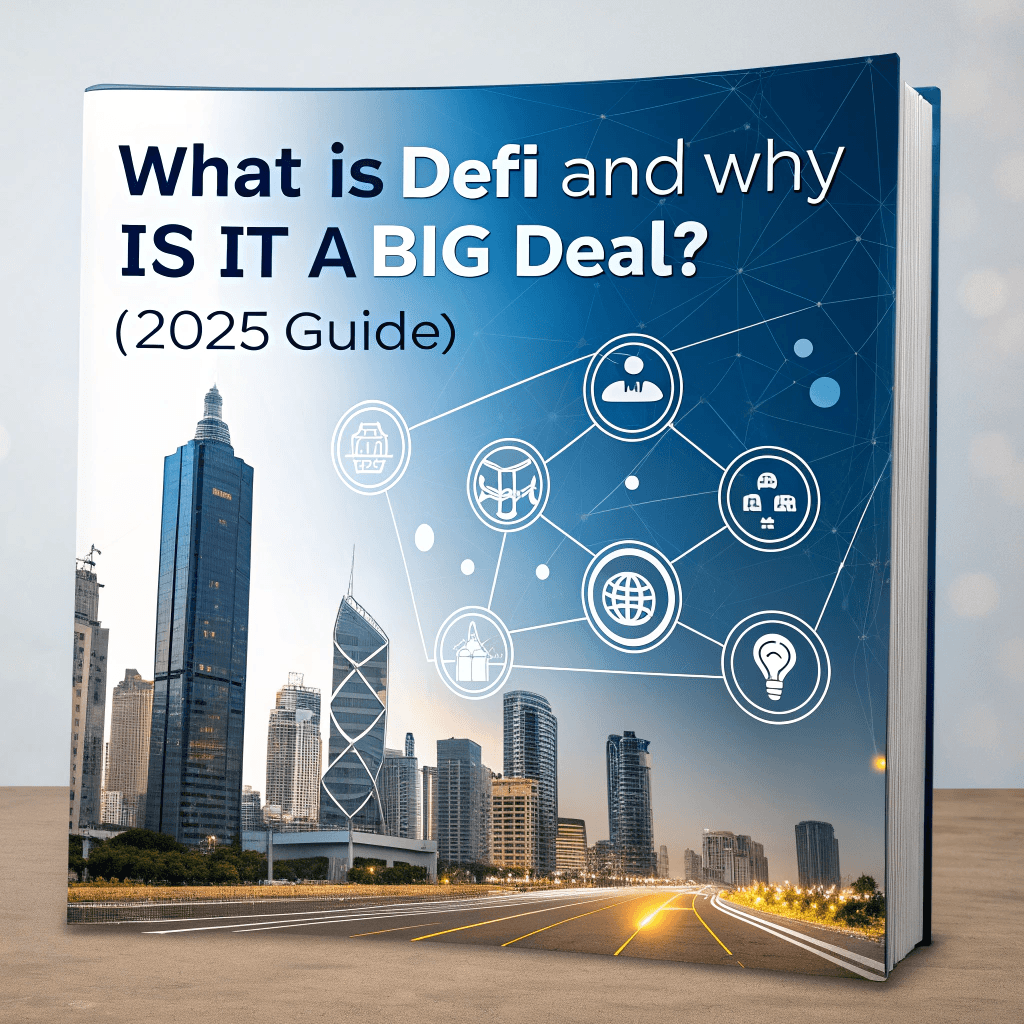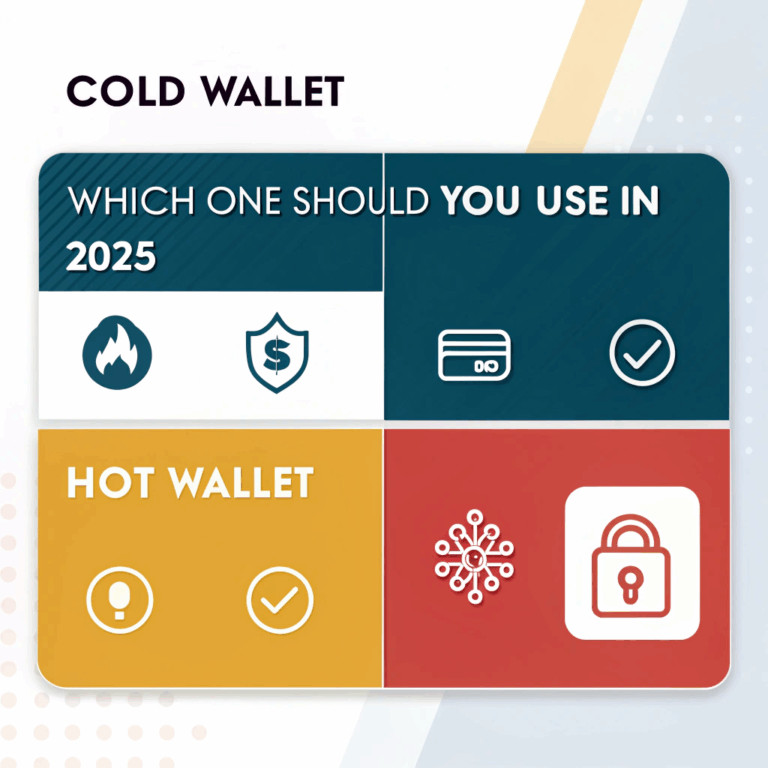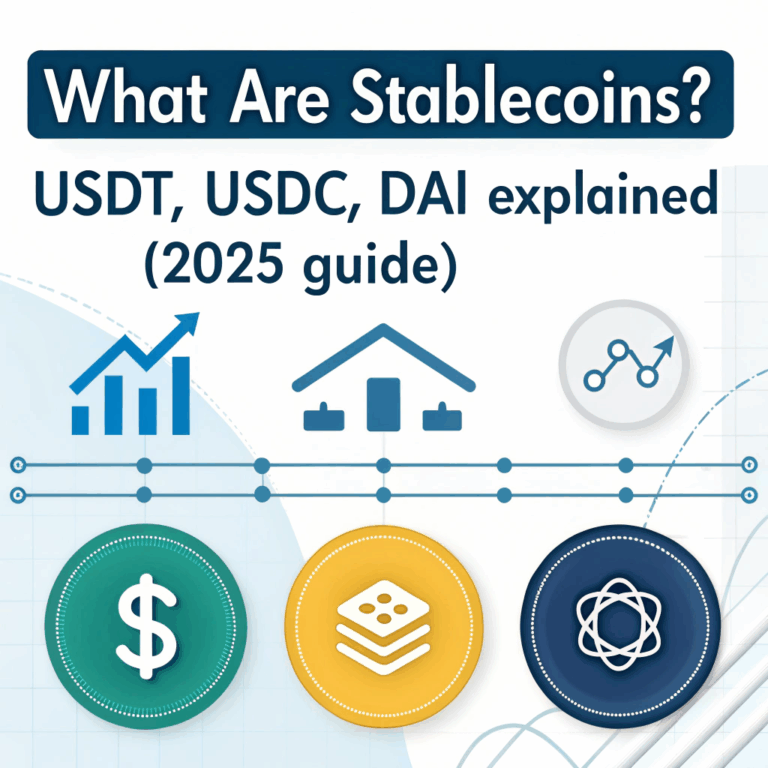What is DeFi and Why Is It a Big Deal? (2025 Guide)

Introduction
Imagine a financial system without banks. No paperwork. No middlemen. Just you, your phone, and the blockchain. That’s the idea behind DeFi — short for Decentralized Finance — a growing movement that’s reshaping how we save, borrow, invest, and earn. And in 2025, it’s bigger than ever.
What Is DeFi?
Decentralized Finance (DeFi) refers to financial services built on blockchain networks — especially Ethereum — that operate without centralized institutions like banks or brokers.
In DeFi, smart contracts (automated code) replace traditional financial intermediaries. You stay in control of your assets at all times.
How DeFi Works (Simplified)
DeFi apps (called dApps) run on public blockchains. Instead of trusting banks, users interact with smart contracts — self-executing code that handles transactions, loans, swaps, and more.
For example:
- You deposit USDC into a DeFi app
- A smart contract locks it and starts earning interest
- No human touches your funds — it’s all on-chain and transparent
Key Differences Between DeFi and Traditional Finance
| Feature | Traditional Finance | DeFi |
|---|---|---|
| Access | Requires ID, approval | Open to anyone with internet |
| Control | Bank/custodian holds funds | User controls private keys |
| Fees | High, bank-driven | Lower, network-driven |
| Speed | Slow (1–3 days) | Instant or near-instant |
| Availability | Office hours | 24/7, global access |
| Transparency | Hidden ledgers | Public blockchain |
Core Components of DeFi
- Stablecoins: Crypto pegged to fiat (e.g., USDT, USDC)
- DEXs (Decentralized Exchanges): Trade crypto without a central party (e.g., Uniswap)
- Lending/Borrowing Protocols: Earn interest or get loans (e.g., Aave, Compound)
- Yield Farming: Earn rewards by providing liquidity
- Staking: Lock up tokens to help secure networks and earn income
- Derivatives & Synthetic Assets: Trade tokenized versions of stocks, commodities, etc.
Popular DeFi Use Cases
- Earning passive income through staking or yield farming
- Borrowing crypto without a credit check
- Trading tokens instantly via DEXs
- Creating synthetic assets to get exposure to stocks or gold
- Remittances and payments across borders without banks
Top DeFi Platforms in 2025
- Uniswap: Largest decentralized exchange
- Aave: Leading lending/borrowing protocol
- Curve Finance: Optimized for stablecoin swaps
- Lido: For Ethereum staking
- GMX: Decentralized derivatives trading
- MakerDAO: Creator of the DAI stablecoin
- Balancer: Automated portfolio manager and DEX
Benefits of DeFi
- No intermediaries — you interact directly with code
- Borderless and inclusive — anyone with internet can join
- Permissionless — no need for approval or KYC (on many platforms)
- Programmable money — automate complex financial actions
- Earn income on idle crypto through staking and lending
- Transparent — every transaction is visible on-chain
Risks and Challenges of DeFi
- Smart contract bugs — code may be exploited
- Rug pulls and scams — fake projects can steal funds
- Impermanent loss — LPs may lose money in volatile pools
- Regulatory uncertainty — many DeFi platforms are unregulated
- High gas fees (on Ethereum mainnet)
Always DYOR (Do Your Own Research) and only use audited, trusted protocols.
How to Get Started with DeFi
- Get a crypto wallet (e.g., MetaMask or Trust Wallet)
- Buy crypto (usually ETH or stablecoins like USDC)
- Connect your wallet to a DeFi platform
- Start exploring — stake, lend, swap, or provide liquidity
- Track your portfolio using apps like DeBank or Zapper
Start with small amounts and learn slowly.
Is DeFi Legal and Regulated?
DeFi exists in a regulatory gray area in many countries. Most platforms are:
- Not registered businesses
- Run by anonymous or decentralized teams
- Not covered by insurance or financial protections
Some governments are starting to regulate DeFi indirectly by targeting developers, front-end websites, or fiat on-ramps.
Future of DeFi in 2025 and Beyond
- More user-friendly interfaces
- Layer 2 adoption (e.g., Arbitrum, Optimism) to lower fees
- Institutional involvement via tokenized assets
- Cross-chain protocols connecting different blockchains
- Legal frameworks being developed in major economies
DeFi is becoming faster, safer, and more scalable — but still experimental.
FAQ
Do I need KYC to use DeFi?
Not usually. Most dApps don’t require ID or approval.
Can I lose money using DeFi?
Yes. From bugs, price fluctuations, or protocol failure. Use caution.
Is DeFi safe in 2025?
Safer than before — but still riskier than traditional finance.
Can I earn passive income with DeFi?
Yes. Through lending, staking, and liquidity provision.
Conclusion
DeFi is more than a buzzword — it’s a new financial system built on code and freedom. While it offers incredible opportunities, it also requires personal responsibility. Understand the tools, start slow, and embrace the future of finance — decentralized, transparent, and open to all.





